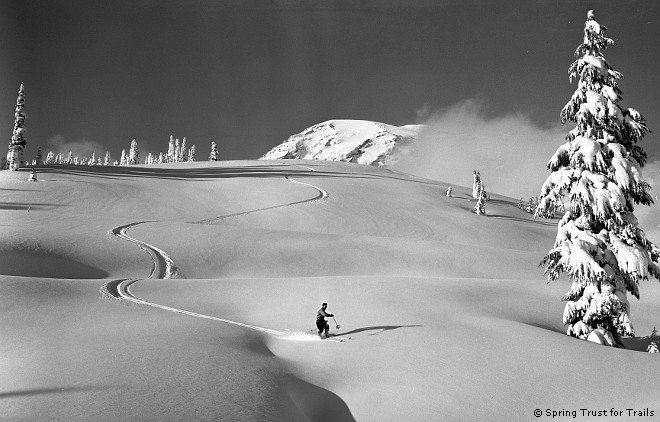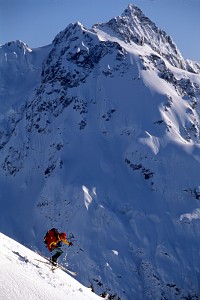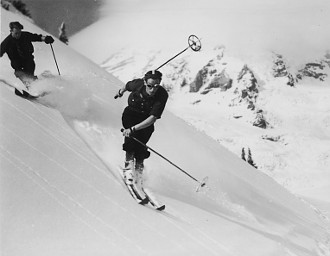

|
| Skiing above Paradise, Mount Rainier in 1948. Photo by Bob and Ira Spring (negative #927). |
The best things in a man’s life are often his hobbies, and if he will not take his hobbies seriously, life will lose half its charm. And mountaineering is something more than a hobby... And so I make no apology for this attempt to trace the history of our noble sport. |
|
Lowell Skoog is a thorough and meticulous guy. It’s what you need in a preservationist. Getting the details right is a required historical imperative. But he is also a passionate and poetic guy when he writes about his love of ski mountaineering in the Cascade Mountains. As he says, “Skiing isn’t just about the turns, but about the people who make them.” At this time in his life, Lowell is attempting to meld his two sides. About ten years ago, Lowell started two big projects: building a database structure that would become the Alpenglow Ski Mountaineering History Project and writing Written in the Snows, a book dedicated to the history of skiing in the Northwest. In a recent telephone interview, he said, “I describe this project like painting a house — only the thing is before you can paint it, you have to build it from scratch, one brick at a time. The bricks being the sources that you find and gradually, as you’re putting together chronologies and grouping things into subjects and finding different references to people and grouping them together — which is what the indexes are that I have on my site — you create a structure of what happened over a hundred years.” And after the house is built? Lowell says, “You stand back with a brush, canvas and easel, and render it into a story, something readable.”
Born in Seattle to skiing, Swedish parents, Lowell and his brothers, Gordy and Carl, grew up hot-dogging at Ski Acres and Crystal Mountain, learned to mountain climb in college and began venturing into the “American Alps” of the North Cascades. A degree in electrical engineering at the University of Washington landed Lowell a job designing computer software, but he used his free time and new climbing skills to explore ever deeper into the Cascade range. Around 2001, he was laid-off from his job during the dot-com bust, and he and his wife, Stephanie, decided he should take six to 10 months to work on the history project. Later, working as an engineering consultant, Lowell was able to devote time to his ski research, a growing number of related projects, and additionally raise a son. His historical enthusiasm is also a way for him to connect to his father, who passed away when Lowell was 20 years old, and the old Scandinavian ski jumpers from his past. On his vast Web site, Alpenglow.org, you can see that Lowell has been busy over the years, not only compiling his historical database, but also ticking off Cascade ski tours with his brothers and other ski partners. Many of the tours would, 25 years later, become the chain links for a ski route stretching 362 miles from Mt. Baker to Mt. Rainier, called “Skiing the Cascade Crest.” The route is dedicated to his late brother, Carl, who died in a steep skiing fall in Argentina in 2005. The Cascade Crest route is a poignant memorial to Carl Skoog, who was an accomplished skier and photographer and Lowell’s most consistent partner on countless trips. Carl’s beautiful imagery can be viewed on Alpenglow.org and the Mountaineers Foundation manages a memorial fund in Carl’s name.
The seed that launched Written in the Snows was Dwight Watson’s obituary published in the Seattle Times in 1996. Lowell recognized Watson’s name from brief passages in the books of Fred Beckey (the prodigious Northwest climber, original dirt bag and guidebook author). Watson, born in 1900, was the first to ski Eldorado Peak, North Star Mountain and Glacier Peak in the North Cascades. Lowell says, “I think his tour de force, in 1939, was the ski traverse of Mt. Baker from the Kulshan cabin to the Mt. Baker ski area, which I started calling Watson’s Traverse.” As Lowell began digging into Northwest skiing history, he contacted Fred Beckey directly. Beckey confirmed that Dwight Watson was the “key guy” in early Northwest ski mountaineering, and that his adventures dated back to the 1930’s. Based on a lead in Watson’s obituary, Lowell contacted the Seattle Mountaineers history committee seeking Watson’s old ski movies. The committee had the films and Lowell was allowed to view them. He was hooked. “So, Watson was the kernel that got me started on the whole project,” he recalls. Lowell eventually became a member of the Mountaineers history committee, allowing him access to more information and, more importantly, the film archives. He refers to these old ski movies as “historical ‘crack,’ because the more you see, the more you want.” He is now the chairman of the committee (like he needs one more thing to do) and is working with the Mountaineers to digitally transfer these “dusty old films dating back to 1928.” He has also gained access to private film sources, like the Bob and Ira Spring collection. The digital video copies are cataloged here.
Around 2002, the Mountaineers history committee wanted to revive the club annuals (journals documenting significant mountain related accomplishments and people), but after three years of trying, couldn’t seem to get it done. Around this time, climbing and skiing forums like cascadeclimbers.com were sprouting-up on the Internet. Lowell and some other like-minded climbers and skiers decided to produce an on-line annual of Northwest climbing and ski mountaineering that was flexible and fresh. The Northwest Mountaineering Journal (NWMJ) was launched in 2004 to provide an edited, permanent, annual record of mountaineering in the Northwest. For seven years, Lowell edited and contributed to the Web site. The NWMJ publishes feature articles and short trip reports documenting new routes in the region. This visually stunning and informative on-line resource was “a very satisfying project” according to Lowell. “I liked seeing all the routes the young hotshots were doing next to profiles of guys that are 90 years old and recalling their glory days.” He says, “The journal was bridging the generations and a very cool thing to be a part of, but very hard and time consuming, too.” Lowell’s last issue as editor of the NWMJ was its seventh and was published last summer. Lowell observed that “my ski history stuff was getting starved,” so he resigned and hopes that someone will take over the journal. He also felt the need to go back to full-time engineering work. But he is obviously clearing the way to finish the book. He says, “I feel like this long drawn-out journey will be better for it. The book remains this unifying goal that I have, this huge mountain that I have to climb, and I’m getting to the point where I have all these pieces that I’m weaving together, and I don’t have any obstacles in my way.” Last fall and winter, Lowell realized that he needed more photography for his book. He says, “I spent a lot of time chasing down pictures at the University of Washington, Museum of History and Industry, Mt. Rainier National Park, and several historical societies.” Lowell’s relationship with the Mountaineers has been especially valuable for obtaining access to photographs held at U.W. However, this endeavor also landed him another task and another distraction — archiving Bob and Ira Spring’s entire black and white photo collection. For those unfamiliar with the Spring twins, they started a photography partnership in 1946 and the two set to photograph Washington State as it had never been photographed before and will never be again. Lowell has another daunting task ahead of him.
With book queries getting a luke-warm reception from publishers like The Mountaineers Books and Sasquatch Books, the publishing process frustrated Lowell. “The book that I have in my brain, would anybody publish it?” He wonders. He says that most publishers responded that the market for his book is too small. Most likely, he will not be publishing Written in the Snows on paper, but instead as an on-line document. I objected that some of us would like his book on our shelves alongside the other beloved tomes of outdoor reference and that he should get paid for all his time and effort. Without hesitation, Lowell says he prefers a living, editable document, more like an on-line magazine than coffee table book. But he adds that he hasn’t given up the idea of publishing a version of the book on paper in the future. During our conversation, I mentioned that Lowell has some classic Northwest ski descents featured in Chris Davenport’s Fifty Classic Ski Descents in North America, an up-coming, slick book of ski pornography to be published in November. I suggested he should do something similar for the Cascades, but he laughed and said he didn’t think his entries were extreme enough for the Colorado guys, “I didn’t select descents that had only been done once, because how can those be classics? Classics should be routes that everyone wants to do. I mean, descents are important, but that is only half the trip.” Shifting our conversation toward Lowell’s vast personal ski experience, I asked him to name his best trip suggestion for a sunny, spring weekend in the North Cascades. He said, “Anything along the North Cascades Highway. For me, the highway has provided decades of personal discovery. You can never go wrong.” When asked to name his worst bushwhacking “suffer fest” of all time he replied, “Carl and I were camped in the col by Mt. Logan at the start of what we hoped would be a grand two-week traverse, and it was raining and snowing. We gave up the trip and thrashed our way out Fisher Creek. It was soul crushing.” Otto Lang, founder of the Mt. Rainier and Mt. Hood Ski Schools, writer, filmmaker and all-around stylish Austrian, said before he died in 2006 that “It doesn’t matter how long it takes you to write a book, it only matters how good it is.” Like the Italian guy that took four years to paint a ceiling in the Sistine Chapel, Lowell Skoog has taken his time writing the definitive history of Northwest ski mountaineering, but when he is finished with his “painting,” I’m sure the details will be correct.
This article was originally published in the October 2010 issue of
Off-Piste Magazine. You can find it online
here.
|
The Alpenglow Gallery



